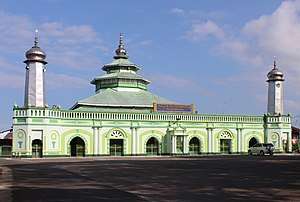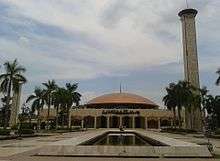Indonesian mosques
For list of notable Indonesian mosques, see List of mosques in Indonesia.
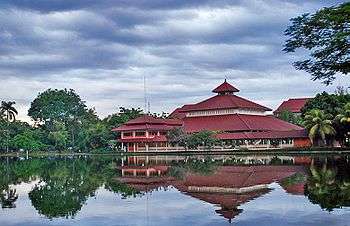
Indonesian mosques refer to the architectural traditions of mosques build in the archipelago of Indonesia. Initial forms of the mosque, for example, were predominantly built in the vernacular Indonesian architectural style which employs Hindu, Buddhist or Chinese architectural elements, and notably didn't equip orthodox form of Islamic architectural elements such as dome and minaret. Vernacular architectural style varies depending on the island and region.
Since the 19th century the mosques began incorporating more orthodox styles which were imported during the Dutch colonial era. Architectural style during this era is characterized by Indo-Islamic or Moorish Revival architectural elements, with onion-shaped dome and arched vault. Minaret was not introduced to full extent until the 19th century, and its introduction was accompanied by the importation of architectural styles of Persian and Ottoman origin with the prominent usage of calligraphy and geometric patterns. During this time, many of the older mosques built in traditional style were renovated, and small domes were added to their square hipped roofs.
History
Islam spread gradually in Indonesia from the 12th century onwards, and especially during the 14th and 15th century. The advent of Islam did not lead to the introduction of a new building tradition, but saw the appropriation of existing architectural forms, which were reinterpreted to suit Muslim requirements.
Early Islamic architecture
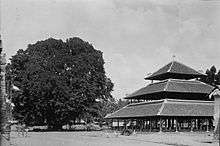
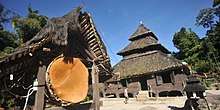
Early Islamic architecture resembles a Majapahit era candi or gates. Most of the early Islamic mosques can still be found in Java, and the architectural style follows the existing building tradition in Java, in which four central posts support a soaring pyramidal roofs. None of the earliest Islamic structures in Sumatra survived. The characteristic of Islamic architecture include multi-tiered roofs, ceremonial gateways, and a variety of decorative elements such as elaborate clay finials for roof peaks. The multi-tiered roofs are derived from the tiered meru roof found in Balinese temple.[1]
The oldest surviving Indonesian mosques are quite large and in most cases were closely associated with palaces.[2] The oldest surviving mosque in Indonesia is the Great Mosque of Demak which is the royal mosque of the Sultanate of Demak, although this is not the oldest Islamic structure. The oldest Islamic structure in Indonesia are parts of the royal palace in Sultanate of Cirebon, Cirebon. The palace complex contains a chronogram which can be read as the Saka equivalent of 1454 CE. Early Islamic palaces retain many features of pre-Islamic architecture which is apparent in the gates or drum towers. The Kasepuhan Palace was probably begun in the late pre-Islamic period, and continued to grow during the Hinduism-to-Islam transitional period. The complex contains clues to the stages of the process of the gradual changes as Islam become incorporated into Indonesian architecture. Two of the Hindu features adopted into Islam in the Palace is the two types of gateways - the split portal (candi bentar) which provides access to the public audience pavilion and the lintel gate (paduraksa) which leads to the front court.

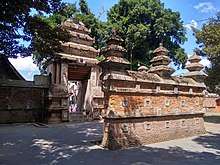
Minarets was not originally an integral part in Indonesian mosque.[1] The Menara Kudus Mosque's tower was built in a Javanese Hindu brick temple style,[3] This tower is not used as a minaret, but as a place for bedug, a huge drum which is beaten to the summons to prayer in Indonesia. This tower is similar to the Drumtowers of Hindu Balinese temples called kul-kul. These suggest a continuation of an earlier Hindu-Buddhist period into the Islamic era in Indonesia.[1]
Intensive spice trade had strong influence on the Indonesian archipelago. As a result, the multi-storied roof architecture of mosques can be found from Aceh to Ambon.[4] The spread of Islam through the Indonesian archipelago can be divided into three distinct historical processes. In Sumatra, the establishment of early Islamic states reflected the emergence of new polities rather than the subjugation of existing kingdoms. In Java, Muslim rulers succeeded to the political power base of Hindu kings; instead of eliminating the earlier ideology, they maintained a high degree of continuity with the past while extending their dominion. In eastern Indonesia (Borneo, Celebes, and Maluku) established rulers simply converted to Islam. These three distinct processes are reflected in the architecture of mosques in different part of the Indonesian Archipelago. In Sumatra, mosques do not occupy a significant position in terms of their spatial relation to the palace of the ruler, rather provides the focus for a wider area which includes the palace complex. In Java, there is a strong relationship between mosque and the ruler's palace, even when they are located far away from each other. This is particularly significant in the case of Masjid Agung (Great Mosques) of Java which are situated within the palace complex. In eastern Indonesia, conversion to Islam simply involved the appropriation of existing religious buildings to serve as mosques.
Traditionally, mosque establishment in Indonesia began with the opening or purchase of land for the mosque. Next is the first construction of the mosque, often using traditional material such as bamboo and thatched roof. The mosque will eventually be made into a permanent mosque and later gradually extended to accommodate the increasing population.
Colonial period
Domes and pointed arches, a well-known features in central, south and southwest Asia did not appear in Indonesia until the 19th century, when they were introduced by Dutch influence over local rulers. Indonesian scholars became familiar with the Near Eastern influence as they began to visit Islamic centers in Egypt and India.[4]
Domes in Indonesia follows the form of the Indian and Persian's onion-shaped dome. These domes first appear in Sumatra. The Grand Mosque of Riau Sultanate in Penyengat Island is the oldest surviving mosque in Indonesia with a dome. There is an indication that the Rao Rao Mosque of West Sumatra employs a dome in its early design.[5] The adoption of dome in mosques of Java was slower than it is in Sumatra.[5] The oldest domed mosque in Java is probably Jami Mosque of Tuban (1928), followed by Great Mosque of Kediri and Al Makmur Mosque of Tanah Abang in Jakarta.[5]
Post-independence


After the establishment of the Republic of Indonesia, many older mosques built in traditional style were renovated and small domes were added to their square hipped roofs. Probably it was built in imitation of similar modifications made to the main mosque in the regional capital nearby.[4]
Since the 1970s, the appropriateness of traditional buildings has been politically acknowledged, and some layered hipped forms have been reinstated. President Suharto contributed to this trend during the 1980s by instigating the Amal Bakti Muslim Pancasila Foundation which subsidized the erection of small mosques in less prosperous communities. The standardized design of these mosques includes three hipped roofs above a square prayer hall, reminiscent of the Great Mosque of Demak.[4]
Today, mosque architecture in Indonesia breaks apart from the multi-tiered traditions of traditional Javanese mosque. Most mosques in Indonesia today follows the Near Eastern influence e.g. Persian, Arabic, or Ottoman style architecture.
By region
Java
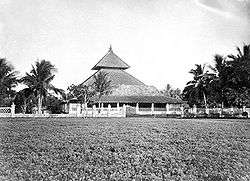
The earliest mosques in Java were built in the mid-15th century onwards, although there is an earlier reference to mosques in the 14th-century Majapahit capital.
Most of the earliest mosques in Java typically include multi-tiered roof. A serambi (roofed porch) attached to the front of the mosque. The minimum number of tiers is two whilst the maximum is five. The top of the roof is decorated with a clay decoration called the mustoko or memolo. Sometimes the roof tiers represent a division into separate floors each of which is used for a different function: the lower floor for prayer, middle floor for study, and top floor for the call to prayer.[6] Minarets were not introduced into Java until the 19th century so that in a one-storeyed mosque, the call to prayer is made from the attached serambi. The highest roof tier is supported by four main pillars, called soko guru. In several of the oldest mosques, one of these pillars is made of wooden splinters held together by metal bands (the significant of which is unknown).
Inside the mosque there is a mihrab in the qibla wall and a wooden minbar. The mihrab niche is made of brick and are highly decorated with deep wood-carving derived from the pre-Islamic art of the area.[6] The enclosure walls are fairly low and decorated with inset bowls and plates from China, Vietnam and elsewhere. In the middle of the east side there is a monumental gate. Some mosques, such as the mosque in Yogyakarta, is further enclosed by a moat.[6]
Other characteristics of these early mosques are a peristyle, courtyard, and gates.[7]
Sumatra
Similar to the mosques of Java, Sumatran mosques share the attributes of Javanese mosque, although it is unfortunate that none of the earliest Islamic structures in Sumatra survived.[1]

In Aceh, royal mosque was a center of armed resistance to the Dutch in the 1870s, and therefore was destroyed in battle. Early prints show it as a structure with wide hipped roofs similar to those of a mosque still standing in the 17th century citadel of Sultan Iskandar Muda.
In West Sumatra, mosques, known as surau, conform the local style with the similar three- or five-tiered roofs as the Javanese mosque, but with the characteristic Minangkabau 'horned' roof profile. The roof is supported on ranks of concentric columns, often focusing on a towering central support which reaches the apex of the building. Some mosques are built on islands in artificial ponds. Traditional Minangkabau woodcarvings may be implemented in the facade.[4]
Many mosques in Pekanbaru and Riau adopts a three- or five-tiered roofs similar to West Sumatra, but with lack of prominent 'horned' roof profile. This gives them appearance of a Javanese-style mosque but with a taller profile.
Kalimantan

The kingdom of Banjar in South Kalimantan was the first Hindu Kingdom in Borneo to convert into Islam after receiving influence from the Sultanate of Demak of Java. The architectural style of the Banjarese mosque shares similarities with the mosques of the Demak sultanates, especially the Great Mosque of Demak. During the course of history, the Banjar develops its own architectural style. One of the main characteristics of Banjar mosque is the three- or five-tiered roof with a steep top roof, compared to the relatively low-angled roof of Javanese mosque. Another characteristic is the absence of serambi (roofed porch) in Banjarese mosques, a traditional feature in Javanese mosques. The Banjarese mosque style is similar with the mosques of West Sumatra and are possibly related to other examples from peninsular Malaysia.[4]
Other characteristics are the employment of stilts in some mosques, a separate roof on the mihrab, the peaks of the roof are decorated with finials called pataka (the mustoko/memolo of Demak Sultanates) made of Borneo ironwood, ornaments on the corner of the roofs called jamang, and fences within the perimeter of the mosque area called kandang rasi. Other differences with the mosques of Java is that the Banjarese mosques contain no serambi (roofed porch), a traditional feature in Javanese mosques.
Banjar-style mosques can be found in Banjarmasin and Pontianak. The mosque Masjid Tinggi in Bagan Serai, Malaysia, is a Banjar-style mosque.
Sulawesi
Mosques in Sulawesi follows the architectural style of Javanese mosque with multiple (usually three) tiered roofs.
Maluku and Papua
Islam came to Maluku in the late 15th century via Java, with the strongest impact was felt in the spice islands of Ternate and Tidore. Features in the oldest mosque in the islands, such as the Sultan's Mosque of Ternate, imitate feature in the oldest Javanese mosques.[4] However, mosques in Maluku lack a peristyle, terrace, courtyard and gate, but retain the multi-tiered roof and centralized ground plan of Javanese mosques.[1] The region of Papua contains few significant mosques, as the region is largely Christian.
References
- Gunawan Tjahjono (1998). Indonesian Heritage-Architecture. Singapore: Archipelago Press. pp. 88–89. ISBN 981-3018-30-5.
- Gunawan Tjahjono (1998). Indonesian Heritage-Architecture. Singapore: Archipelago Press. pp. 94–95. ISBN 981-3018-30-5.
- Gunawan Tjahjono (1998). Indonesian Heritage-Architecture. Singapore: Archipelago Press. pp. 86–87. ISBN 981-3018-30-5.
- Gunawan Tjahjono (1998). Indonesian Heritage-Architecture. Singapore: Archipelago Press. pp. 96–97. ISBN 981-3018-30-5.
- Mukhlis PaEni (2009). Sejarah Kebudayaan Indonesia: Arsitektur (in Indonesian). Jakarta: Raja Grafindo Persada. pp. 251–255. ISBN 9789797692704.
- Petersen, Andrew (2002). Dictionary of Islamic Architecture. Routledge. pp. 131–134. ISBN 9780203203873. Retrieved January 6, 2013.
- Miksic, John (1996). Ancient History. Singapore: Archipelago Press. pp. 126–127. ISBN 981-3018-26-7.



